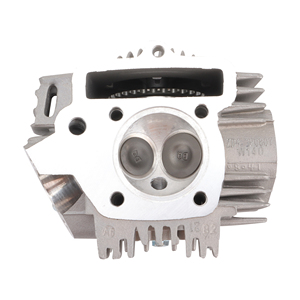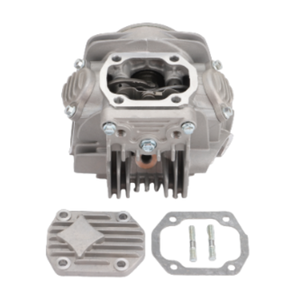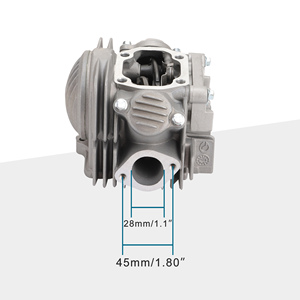
All categories
Featured selections
Trade Assurance
Buyer Central
Help Center
Get the app
Become a supplier

(2545 products available)












































Engine parts for pit bike are called pit bike engines and are similar to small motorcycle engines. They are typically four-stroke or two-stroke and are designed to be compact and lightweight. A pit bike engine is made up of various parts that work together to create engine parts for a pit bike.
Engine Displacement
Most pit bikes have 110cc to 150cc engines. Mechanics call this engine displacement. It shows how much air and fuel the engine can use. Bikes with bigger engine displacement go faster and have more power.
Engine Configuration
Most pit bikes have single-cylinder, four-stroke engines. That means there is one cylinder and the engine does four strokes (suck, compress, explode, waste) for each cycle. These engines are simple and need little maintenance. Some pit bikes, especially newer or fancier ones, can have twin-cylinder or triple-cylinder engines. These have two or three cylinders, but they are not as common.
Cylinder Size
The diameter of the cylinder in a pit bike engine is usually between 50mm to 60mm. This is called bore size. A bigger bore means the engine can pull in more air and fuel, giving more power. But it can also make the engine run hotter. The length of the cylinder is called stroke length. Pit bike engines have a stroke length of 40mm to 50mm. A longer stroke makes the engine even more powerful.
Fuel Type
Most pit bikes run on unleaded petrol. This is the same fuel used in cars. Some newer or racing pit bikes may need higher octane fuel (like 98 RON). But for regular use, unleaded petrol with 91 RON octane is fine.
Oil Type
Pit bike engines need 4-stroke motor oil. Look for oils that say ""4T"" or ""four-stroke"" on the bottle. They should also meet the ""API SL/SG"" or ""JASO MA"" standards. These oils protect engine parts and help it run smoothly. Change the oil every 3000 km or so.
There are several factors to consider before choosing any engine part for a pit bike. Here are some of them:
Compatibility
When selecting engine parts for a pit bike, compatibility is a must. This is because the parts must be designed and constructed to fit into the bike's specific engine model. This will ensure seamless operation and performance. Compatibility can be achieved by cross-referencing the specifications of the engine parts with the details of the pit bike's engine. The details needed include the make, model, and year of the pit bike.
Quality
Quality is a very important aspect to consider when selecting engine parts for a pit bike. This is essential because high-quality engine parts improve the performance and reliability of the pit bike. This also means that the engine parts will reduce wear and damage. This will ultimately result in the engine parts lasting longer. This, however, means that the engine parts must be of premium quality. Engine parts of premium quality are expensive, but they are worth the investment.
Budget
Budget is a great factor to consider when selecting engine parts for a pit bike. This is because of the numerous options available in the market. The engine parts are available in different qualities, grades, and levels. This makes it easy to find engine parts that will fit into the budget. However, it is important to note that engine parts with higher performance capabilities come at a higher price.
Identify the issue
Check the pit bike's owner's manual or take the pit bike to a mechanic to identify the engine part that needs to be replaced.
Get the right tools
Have the right tools needed for the replacement process. These tools include screwdrivers, wrenches, sockets, and Allen keys. Additionally, have the replacement part ready.
Turn off the engine and disconnect the battery
Before working on any engine parts, ensure the engine is off to avoid any accidents and disconnect the battery to avoid any electrical shorts.
Follow the manual
Check the owner's manual and pit bike service manual to see the instructions on replacing the specific part that needs replacement. The manual provides the steps needed to remove and install the part safely and effectively.
Remove the old part
Use the right tools to remove the old and damaged parts carefully. Be careful not to damage any surrounding parts or components.
Install the new part
Follow the instructions in the service manual to install the new part. Make sure to tighten all bolts and screws to the manufacturer's specifications.
Reconnect the battery and start the engine
Once the new part is installed, reconnect the battery and start the engine to ensure everything is working properly.
Dispose of the old part
Dispose of the old and removed part following local regulations. Some engine parts may be recyclable, so be sure to dispose of them properly.
Q: What are the common problems with pit bikes?
A: There are many problems that users can encounter. However, the major ones have been mentioned above. In case of any engine problem, users should be advised to seek the services of a mechanic. If they want to do it by themselves, they should refer to the owners' manual.
Q: How often should a pit bike engine be serviced?
A: The frequency of engine service depends on the usage of the pit bike. For regular riders, a monthly service is recommended. For occasional use, a quarterly service is sufficient.
Q: What is the recommended oil for pit bike engines?
A: The recommended oil is one that meets the specifications in the owner's manual. Usually, it's a high-quality synthetic or mineral oil, depending on the bike's requirements.
Q: Can pit bikes run on unleaded fuel?
A: Yes, pit bikes can run on unleaded fuel. Ensure that the fuel meets the octane requirements specified in the owner's manual.